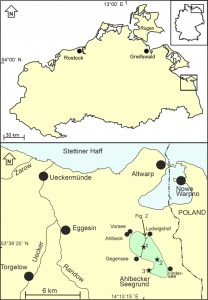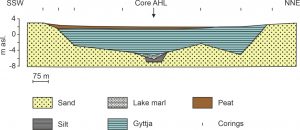A palynological record of the Ahlbecker Seegrund (NE Germany)
In the search for pollen diagrams from NE Germany for the study of patterns in vegetation and sedimentation during the Weichselian Lateglacial it was discovered that many unpublished palynological data from the period of the German Democratic Republic are preserved in archives of research institutes. In order to save these data from oblivion and to make them available to the scientific audience, part of the material was digitalised and published (see revision of old palynological data from E Germany). One of the pollen records from the legacy of Franz Fukarek is from the Ahlbecker Seegrund in eastern Mecklenburg-Vorpommern.
 Location of the study area in eastern Mecklenburg-Vorpommern. Indicated are the locations of the cross-section, and of 1: core Ahlbecker Seegrund (analysed by Fukarek), 2: core Ahlbecker See (Herking 2002; Jahns & Herking 2002a, b; Herking & Wiethold 2004), 3: core Kleiner Fauler See (Herking 2002; Jahns & Herking 2002a, b).
Location of the study area in eastern Mecklenburg-Vorpommern. Indicated are the locations of the cross-section, and of 1: core Ahlbecker Seegrund (analysed by Fukarek), 2: core Ahlbecker See (Herking 2002; Jahns & Herking 2002a, b; Herking & Wiethold 2004), 3: core Kleiner Fauler See (Herking 2002; Jahns & Herking 2002a, b).
This area is part of the region of the Weichselian proglacial lake known as the “Hafstausee”. Extensive geomorphological research of this area already took place in the 1960s by Bramer (1963, 1964, 1972, 1975, 1979). This research was supplemented with palynological analyses on five cores carried out by Franz Fukarek, four of them from the area of the Friedländer Große Wiese (De Klerk 2004), and the fifth in the Ahlbecker Seegrund. Recent palynological research of the Ahlbecker Seegrund and the nearby Kleiner Fauler See was presented by Herking (2002) and Jahns & Herking (2002a, b) (cf. Jahns et al. 2002; Herking & Wiethold 2004), and together with the pollen diagram by Franz Fukarek they provide a comprehensive overview on vegetation history and environmental development of the area.
 Lithological cross-section through the Ahlbecker Seegrund, modified after Bramer (1964, 1979). For Indicated is the location of the palynologically analysed core Ahlbecker Seegrund (AHL).
Lithological cross-section through the Ahlbecker Seegrund, modified after Bramer (1964, 1979). For Indicated is the location of the palynologically analysed core Ahlbecker Seegrund (AHL).
The Ahlbecker Seegrund is a former lake with a length of c. 6 km and a maximum width of around 2 km. The genesis of the lake is assumed to be connected with the melting of a residual glacial tongue of the large Weichselian Oder glacier (Herking 2002; Jahns & Herking 2002a). The sands surrounding the basin were deposited in the proglacial lake that prevailed in the area after the melting of the Weichselian inland ice. A lithological cross-section by Bramer (1964, 1979) shows a large infill with gyttja, with in its centre a narrow area filled with silt and lake marl. A thin peat layer covers the gyttja. Core AHL – that was palynologically analysed by Fukarek – was retrieved in the central area of the cross-section and has a length of 875 cm. The palynologically analysed core “Ahlbecker See” of Herking (2002) and Jahns & Herking (2002a/b) stems from a spot in the central area of the former lake ca. 2 km southeast of core AHL, and their core “Kleiner Fauler See” originates from a terrestrialised bay of the former lake.
The pollen diagram will be uploaded soon…
The pollen diagram covers the period from the Weichselian Lateglacial up to the late Holocene, but shows a hiatus in the early Holocene. It has for NE Germany, especially in the 1960s, an exceptionally high temporal resolution that provides a good picture of the regional vegetation development. Palaeoecological and palaeoenvironmental information on the development of the lake itself, however, is limited since only few pollen attributable to wetland taxa occur: this is probably due to the large distance from the analysed core to wetland vegetation types along the lake margins. Pollen types attributable to open water taxa occur only sporadically. The comparison with more recent pollen diagrams from the former Ahlbecker See of Herking (2002) and Jahns & Herking (2002a/b) show that changes in sedimentation within the lake did not occur synchronous, but at different moments at different spots. After several terrestrialisation phases that will have induced peat formation, the lake was drained in the 18th and 19th Century (Hellmundt 1962; Herking 2002).
Publication:
De Klerk, P. (2005): A pollen diagram from the Ahlbecker Seegrund (Ueckermünder Heide, Vorpommern, NE Germany) from the legacy of Franz Fukarek. Archiv für Naturschutz und Landschaftsforschung 44(3): 93-108.
Related literature:
Bramer, H. (1963): Zur Entstehung der Friedländer Großen Wiese und des Galenbecker Sees (Naturschutzgebiet) (Vorläufige Mitteilung). Naturschutzarbeit in Mecklenburg 6: 14-23.
Bramer, H. (1964): Das Haffstausee-Gebiet: Untersuchungen zur Entwicklungsgeschichte im Spät- und Postglazial. Habilitation-thesis, Greifswald University.
Bramer, H. (1972): Besonderheiten bei der Ausbildung eines Stausees im Bereich der Marginalzonen der letzten Vereisung. Wissenschaftliche Zeitschrift der Ernst-Moritz-Arndt-Universität Greifswald 21, Mathematisch-naturwissenschaftliche Reihe 1: 63-65.
Bramer, H. (1975): Über ein Vorkommen von Allerödtorf in Sedimenten der Ueckermünder Heide. Wissenschaftliche Zeitschrift der Ernst-Moritz-Arndt-Universität Greifswald 24, Mathematisch-naturwissenschaftliche Reihe 3/4: 183-187.
Bramer, H. (1979): Beiträge zur Physischen Geographie des Kreises Ueckermünde, Bezirk Neubrandenburg. Pädagogisches Kreiskabinett Ueckermünde.
De Klerk, P. (2004): Vegetation history and landscape development of the Friedländer Große Wiese region (Vorpommern, NE Germany) inferred from four pollen diagrams of Franz Fukarek. Eiszeitalter und Gegenwart 54: 71-94.
Herking, C. (2002): Der menschliche Einfluß auf die Vegetation im Umkreis des Ahlbecker Sees und des Kleinen Faulen Sees, Kreis Uecker-Randow, im Spiegel pollenanalytischer Untersuchungen. Archäologische Berichte aus Mecklenburg-Vorpommern 9: 16-25.
Herking, C. & Wiethold, J. (2004): Klima und Vegetation während der Bronzezeit – Pollenanalytische Untersuchungen zur Rekonstruktion prähistorischer Umweltveränderungen. Archäologie in Mecklenburg-Vorpommern 3: 18-23.
Jahns, S. & Herking, C. (2002a): Zur holozänen und spätpleistozänen Vegetationsgeschichte im westlichen Odergebiet. Römisch-Germanische Forschungen 60: 33-49.
Jahns, S. & Herking, C. (2002b): Der menschliche Einfluss auf die Vegetation im westlichen unteren Odergebiet im Spiegel der pollenanalytischen Untersuchungen. Römisch-Germanische Forschungen 60: 373-381.
Jahns, S., Herking, C. & Kloss, K. (2002): Landschaftsrekonstruktion entlang des westlichen unteren Oderlaufs anhand ausgewählter Pollenkurven aus acht Seeprofilen. Greifswalder Geographische Arbeiten 26: 153-156.
Your e-mail address will not be published.